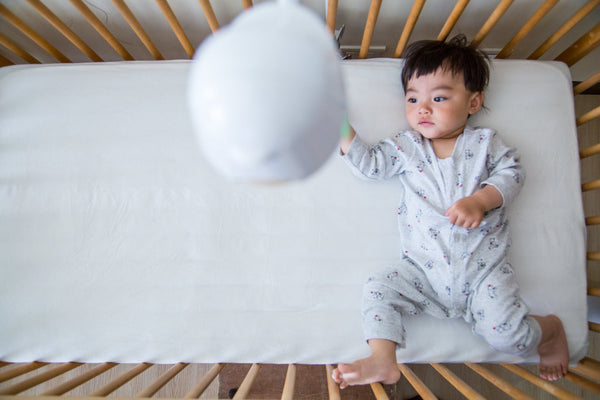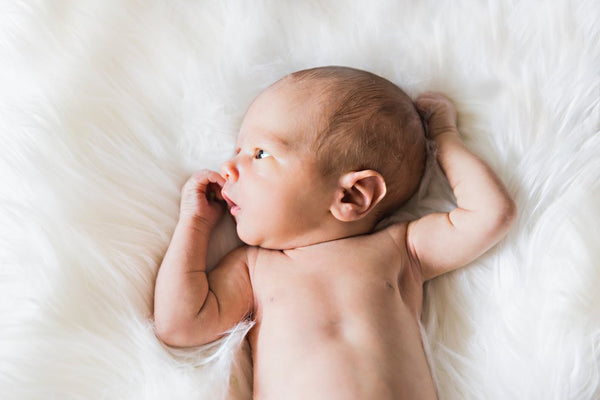What do you do if your baby has a fever? This has always been the most common worry for new parents with a newly sick baby.
The most obvious visible symptom of a baby’s fever is reduced mobility. Especially when the baby’s fever is above 102 degrees (F), which is when parents are right to be very nervous. They want to know the cause of the baby’s fever and to get them back to a regular temperature as soon as possible.
So, try not to panic, here are some steps to take when you see that your baby’s temperature is unnaturally high.
Baby Fever Treatment in 3 Steps
Babies’ heat regulation is relatively poor. If the degree of your baby’s temperature is high, the first consideration is whether they’re wearing too many clothes, or the temperature is too high in the room. If your baby doesn’t have chills and isn’t shivering, you can consider removing excess clothes first and turning on the air conditioner to see if the body temperature drops naturally. Set a schedule to continue checking their temperature and if it still won’t come down, you should look for other causes for the fever.
Infection is the main cause of fever. If the baby is less than 3 months old, you must seek medical treatment as soon as possible because if the baby is severely infected at this age, they may not be able to express any discomfort. There is a great need to be hospitalized for a detailed examination and to rule out anything dangerous.
For older babies, parents can first let the baby take the antipyretic (fever-reducing) medicine at home and observe the activity of the fever. If the mobility after the fever is good, you can visit the pediatric clinic for follow-up.

Top Baby Fever Symptoms To Watch Out For
A few tell-tale signs of a baby fever emergency are poor mobility, shortness of breath, or spasms. If none of these signs are visible, and your baby is over 3 months old, you don’t need to rush to the emergency department given that the first step they’ll try to take is to reduce the fever themselves.
Often, you can get started with those steps before going to the hospital, and if it makes you feel more comfortable, make preparations to visit the hospital as you take these preliminary steps. (Further reading: promoting baby sleep safety- 4 key reminders)
Steps To Take When Baby Has A Fever
Step 1: Check your baby’s condition and environment
- Is the baby shivering?
- Are they baby overly dressed?
- Is the room temperature too high/
(It is recommended that the indoor temperature suitable for newborns is 72 -82 degrees F. Your Cubo AI baby monitor can alert you if your nursery’s temperature is unsuitable
Step 2: Help Reduce Your Baby’s Fever
- Infants under 3 months must see a doctor as soon as possible
- Babies over 3 months can take the fever-reducing medicine first
Step 3: Keep an Eye On Baby After Fever Reduces
- If fever reduces after medication -> take the baby to a pediatric clinic for follow-up
- Or If after the medicine symptoms continue: low mobility, shortness of breath, etc., go to the Emergency Room

Baby Fever-Reducing Methods and Precautions
In addition to taking antipyretics (fever-reducing medicine), what are other ways to reduce a baby fever? In fact, fever is a process of ups-and-downs in temperature, so to speak. When going up, antipyretics are the only effective way. When going down, helping the body to dissipate heat can help reduce fever.
Many parents will let their children bathe in warm water, or wipe their bodies with warm towels, and apply antipyretic stickers. These methods are mostly unnecessary, but they will not cause problems.
Some ancient methods are actually harmful. For example, using an ice pillow may make children shiver, even more so when the temperature is going up. Wiping the body with alcohol will make the pores shrink and make it difficult to dissipate heat.
(Further reading: 5 safety rules for newborn crib arrangement)
Special Conditions
A baby with a common cold or gastroenteritis-induced fever will probably be back to a regular temperature in three days. Some viruses may cause for a long time, such as adenovirus, Epstein-Barr virus, herpes simplex virus that causes herpes gingival stomatitis. If diagnosed, it will be more mentally prepared for fever for a few days.
If they have a fever for more than three days, then you can start to wonder if there is a urinary tract infection. Is there pneumonia? Are there flu complications, such as sinusitis or otitis media, and so on. Depending on the child’s clinical situation, blood tests, urine tests, or chest X-rays can be arranged.
Fever is a necessary process of raising children, it is easy to get medical treatment so it is recommended to see a doctor when baby has a fever. Occasionally doctors encounter patients who have had a fever for five days by the time they see a doctor, and it can make the diagnosis process more difficult. Let the doctor look at the baby during the early days to make a record, then follow-up if necessary to create a clear picture for the physician.
